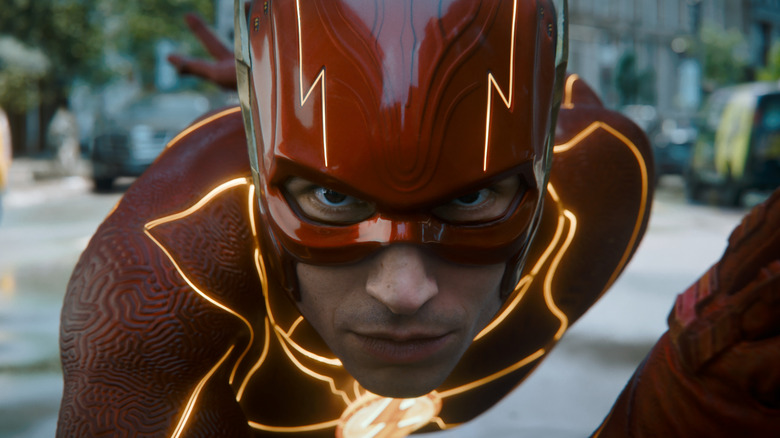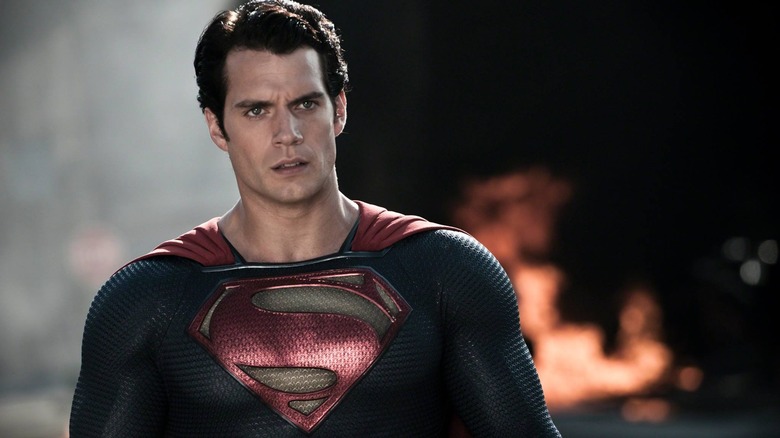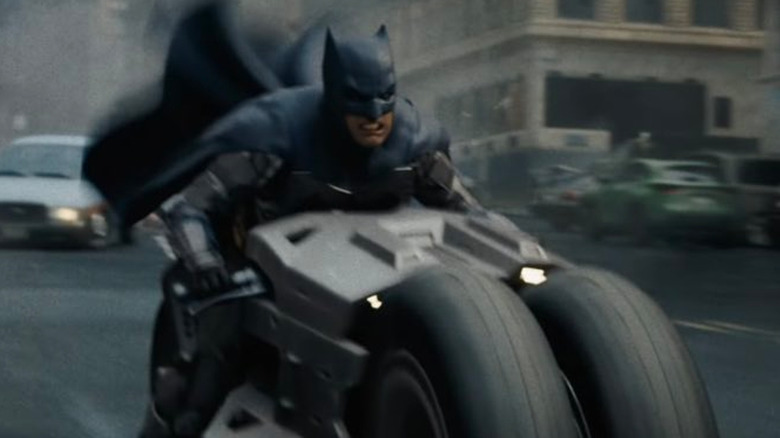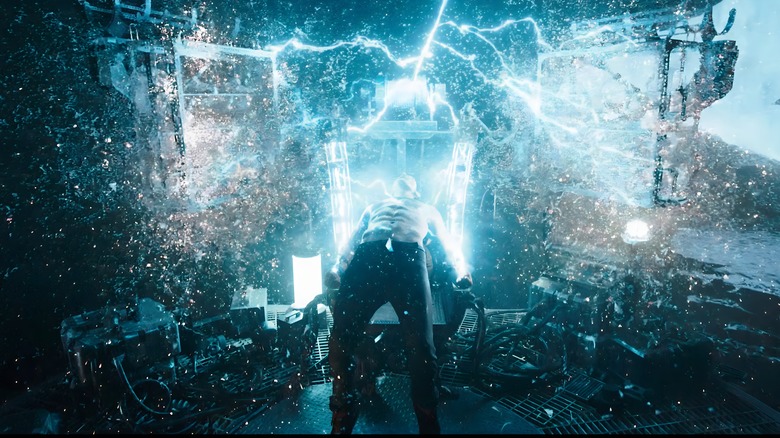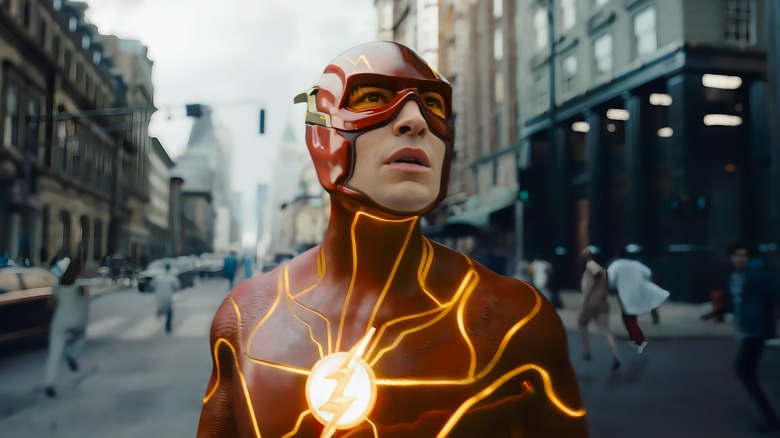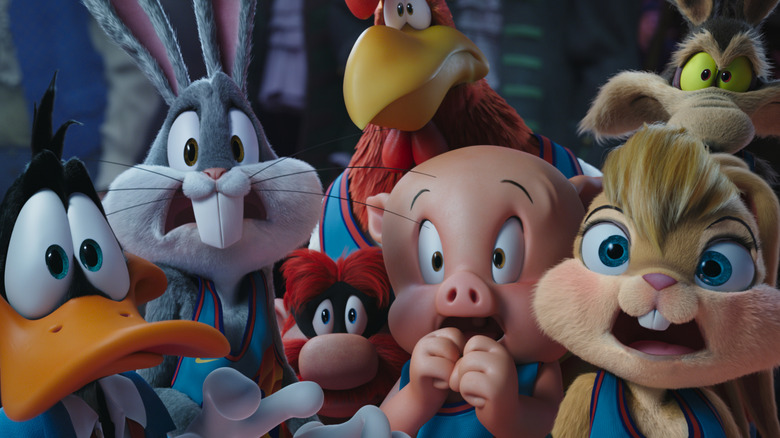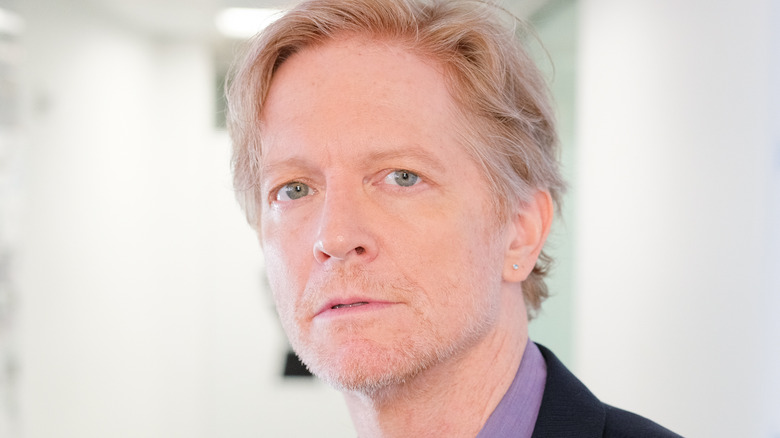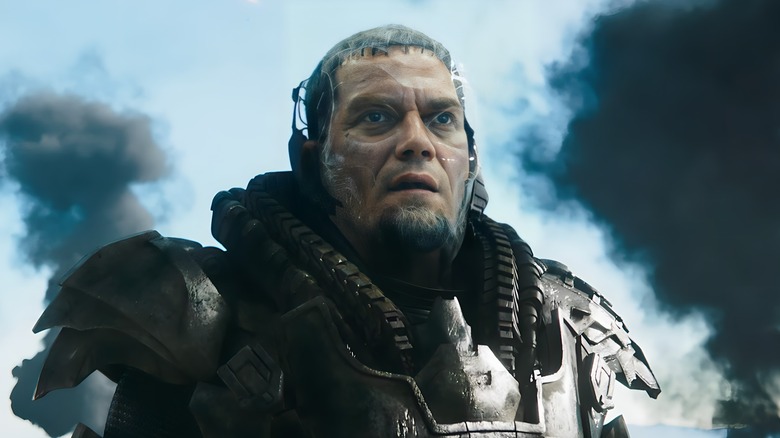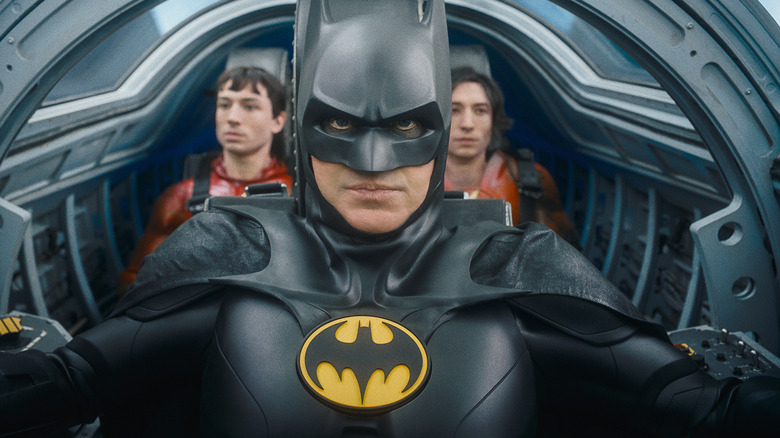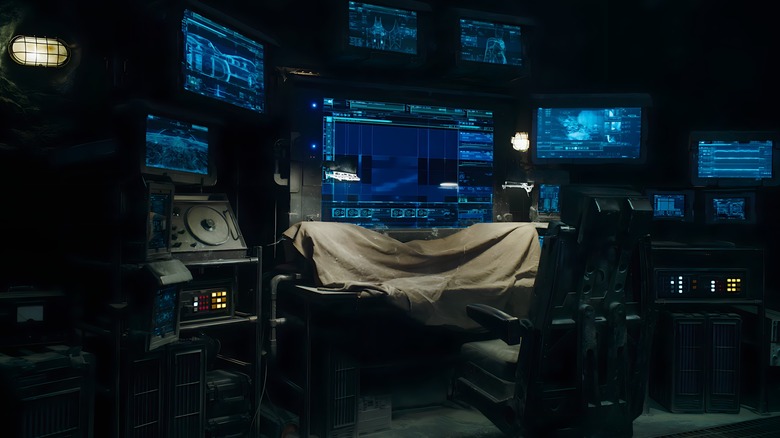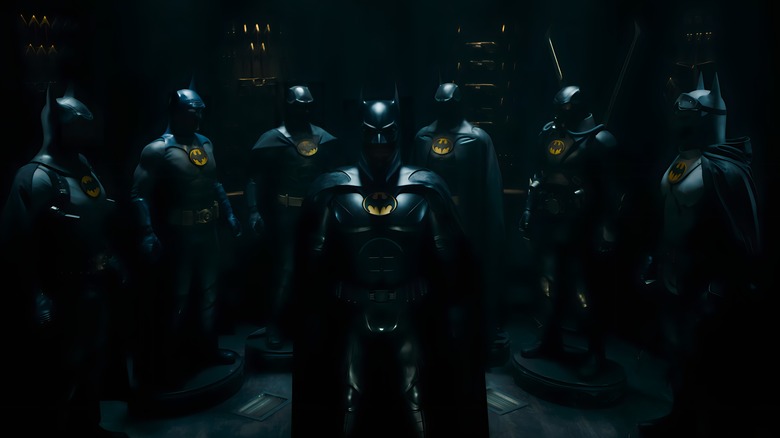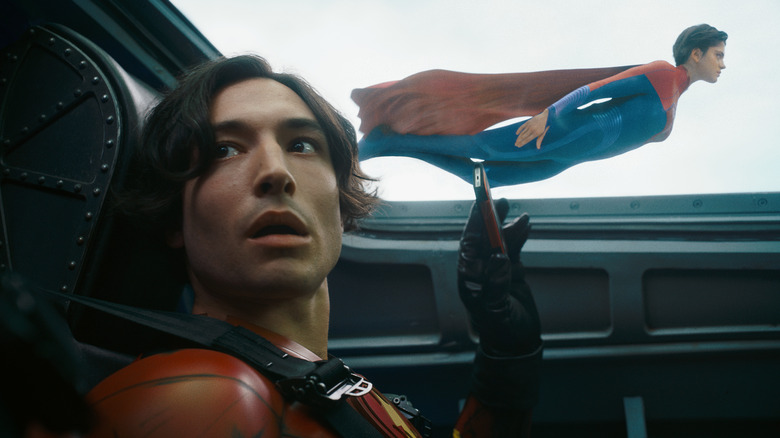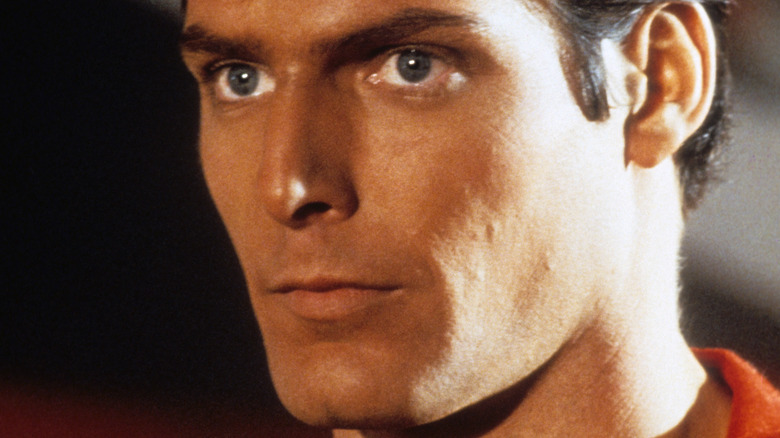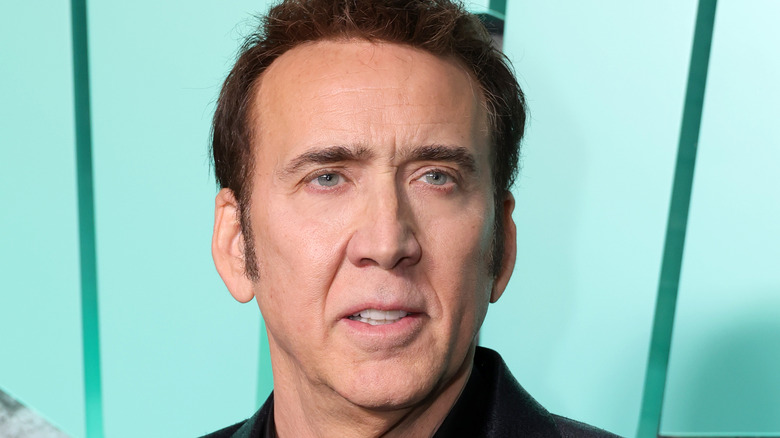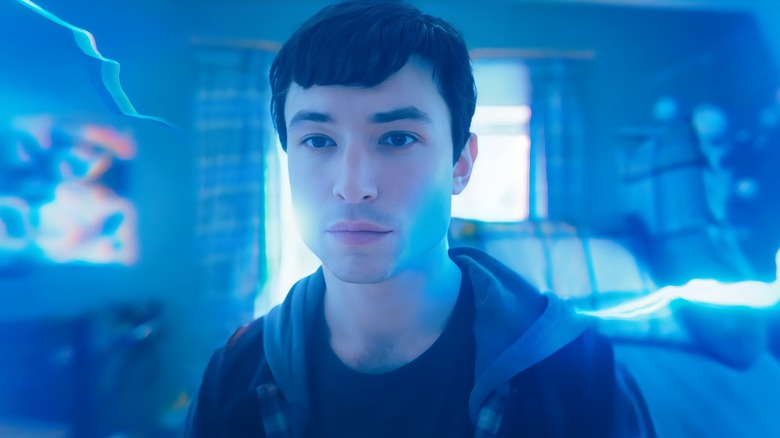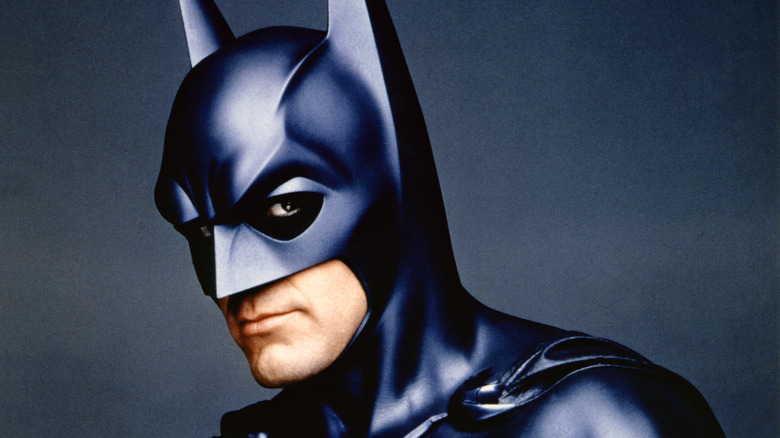Easter Eggs And References You Missed In The Flash
Contains spoilers for "The Flash"
After years and years of delays, director swaps, and overall chaos, "The Flash" is finally here, and it is ... many things. It's a quasi-finale for the old DCEU (but also not really, because "Aquaman 2" is still coming out later this year). It's a big-budget rendition of the famous "Flashpoint" storyline from the comics, albeit with more than a few changes. It's a massive vehicle for its lead star, Ezra Miller, who has courted controversy and criminal proceedings for the past few years. And of course, because this is both a contemporary superhero blockbuster and a Warner Bros. movie, "The Flash" is also rife with Easter eggs and references.
As a multiverse story, the film features ample opportunities for nods at alternate DC timelines. Is it the best multiverse movie in the recent deluge of the burgeoning mini-genre? Well, delays forced it to play catchup, coming out after "Spider-Man: Across the Spider-Verse," "Spider-Man: No Way Home," and "Everything Everywhere All at Once," so no. But does it have a ton of references, for better or worse? Oh yes, it definitely has those.
Aside from the obvious parallels to the comics' "Flashpoint" arc, there are plenty of little details to keep an eye out for. Here are some Easter eggs and hidden references that you might have missed in "The Flash."
Superman vs. the Volcano
At the beginning of "The Flash," Barry Allen is waiting in line for a custom breakfast sandwich when he gets a call from Alfred Pennyworth (Jeremy Irons). Chaos has broken out in Gotham City, and Batman (Ben Affleck) needs The Flash. Starving and already late for work, the ever-complaining speedster asks if Superman might be able to lend a hand instead. However, as both Alfred and the TV broadcast tell him, Kal-El is busy fighting a volcano in Guatemala.
While not quite overt, this moment can be read as a reference to one of Superman's first cinematic outings. In the early 1940s, Fleischer Studios produced a series of animated shorts starring the Man of Steel. One of these, simply entitled "Volcano," has Superman saving people from the eruption of, well, you guessed it. Given how many past incarnations of Supes are directly referenced later in the film, this feels too spot-on to be a coincidence. It's just a shame that fans couldn't catch one last glimpse of Henry Cavill.
Batfleck's Batcycle
Michael Keaton fans aren't the only ones treated to some proper Batman action in "The Flash." The opening set piece in Gotham sees the Dark Knight chasing down a gang of two-bit crooks who've stolen a dangerous (but comically vague) pathogen. It's the kind of classic, broad daylight chase that Batfleck never really got to do in his previous movies, and it evokes the Christian Bale "Batman" series in more ways than one.
First and foremost, there's Bruce Wayne's heavy-duty Batcycle, which bears a striking resemblance to the one Bale's character drives in "The Dark Knight" and "The Dark Knight Rises." The massive wheels and fancy gadgets remind audiences of those prior films, but of course, the Batcycle didn't start with Christopher Nolan. There have been numerous incarnations of Batman's motorcycle in the comics dating back to the 1950s. Even Robert Pattinson's Caped Crusader rides one in "The Batman," albeit a version that actually fits with his Bruce Wayne alter ego.
It's also worth noting that the criminals Batman is chasing in this sequence are led by another comic book character. The credits identify their leader as Al Falcone, which is likely short for Alberto Falcone. In the comics, the villainous Alberto is the son of notorious Gotham crime lord Carmine Falcone, last portrayed in live-action by John Turturro in "The Batman."
Not quite the Cosmic Treadmill
Though the name is never used and the device itself is never constructed, Barry's method of traveling back through time in "The Flash" evokes the Cosmic Treadmill. One of the character's primary methods of time travel in the comics, the treadmill was powered by cosmic energy and designed to make jumping into the past and future easy. In the "Flash" TV show, a different version of the treadmill appears, playing a major role in a number of Arrowverse events.
The movie doesn't employ an actual treadmill, but the visual effect of Barry's time travel seems intended to reference it. Once he starts running fast enough, he enters what the film refers to as the "chronobowl," which lays out temporal events in 360 degrees around him. Once there, he runs in place at varying speeds to either go forward or backward in time, thus causing the surrounding events to expand outward or collapse into him. The mechanic of running in place is sure to make comic or Arrowverse fans think of the Cosmic Treadmill, even though the actual action is different.
Enter the Snyderverse?
One of the most interesting tidbits dropped in "The Flash" occurs in a brief exchange between Barry and Bruce Wayne. After Barry realizes that he can enter the chronobowl and go back in time, Bruce tells him not to mess with the past, as doing so could unravel the very fabric of reality. Barry counters by referencing the last time he managed to change time in Pozharnov — the Russian city from "Justice League."
Here's the thing, though: Barry's "one second" jump into the past at Pozharnov only occurs in the "Snyder Cut" of "Justice League," not the original film. Joss Whedon's version has Superman step in and defeat Steppenwolf before he can activate the Mother Boxes. But in Zack Snyder's version, the villain wins, forcing the Flash to run back in time and prevent it from happening.
By having Barry and Bruce reference this event, "The Flash" seems to make the "Snyder Cut" version of the story canon. Larger implications of that would be the continued existence of Darkseid, the Green Lantern Corps, and Martian Manhunter's partnership with Batman. Since the new DCU is effectively rewriting the whole movie timeline (a process that "The Flash" facilitates), these revelations probably won't have any resounding impact. Still, it's curious to see the franchise give canonical credence to the film's infamous director's cut.
Way too many Warner Bros. references
If you thought that Warner Bros. would be content simply to reference its other DC properties in "The Flash," think again. At times, the movie becomes a veritable "Space Jam: A New Legacy" of unnecessary, shoehorned nods to other WB brands.
Barry Allen's bedroom in the "Flashpoint" timeline is covered with movie posters for other Warner Bros. films, including "Pacific Rim," "V for Vendetta," and "Inception." His apartment is similarly adorned, featuring a "Mars Attacks!" poster and computer monitor wallpaper of both "Mortal Kombat" and "Looney Tunes." Crazy how everything Barry loves was produced or distributed by WB, isn't it?
When he's learning from the main Barry how to use his new powers, "Flashpoint" Barry even makes a direct "Looney Tunes" reference by invoking Speedy Gonzalez, famously the fastest mouse in all of Mexico. He does the classic wind-up pose from Speedy's cartoons before launching off into a rapid sprint. It's kind of fun, but it's also likely to leave an icky "look at all this IP we own" taste in your mouth.
Castings from another dimension
One of the key differences in the "Flashpoint" timeline has to do with "Back to the Future." Given the beloved film's subject matter, it makes sense as a reference point, but the actual gimmick used in "The Flash" pulls from the movie's complicated production history. In the new reality that Barry creates, Eric Stoltz plays Marty McFly in "Back to the Future" instead of Michael J. Fox. If you're familiar with the film, you'll know that Stoltz was indeed cast in the leading role before Fox was brought on.
In fact, production began with Stoltz starring and continued for a number of weeks. Eventually, he was fired because his acting style was deemed too serious, and Fox was brought in to replace him. When the original Barry mentions Fox to his doppelganger and his roommates, they say that the actor actually appeared in "Footloose," and that Kevin Bacon starred in "Top Gun." This, too, is referencing some real cinematic history, as Tom Cruise was considered for the lead in "Footloose" before Bacon was cast.
These are just a few of the quirky differences in the "Flashpoint" universe. The younger Barry also mentions some bizarre restaurants, including a chain called "Downtown Abby's" that, according to him, is basically a "cheaper Bananabees." How quirky!
Zod's return
As revealed in the early trailers for "The Flash," General Zod (Michael Shannon) is back. Just like in "Man of Steel," he invades Earth with his Kryptonian forces in search of a rebel ex-pat. Only this time, that target ends up being Kara Zor-El (Sasha Calle) instead of Superman.
With Zod come a bunch of other specifics from the Zack Snyder film. The creepy, staticky announcement video that he broadcasts to the world is the same one seen in "Man of Steel," as is his ship, his power suit, and the gear of his forces. Antje Traue also reprises the role of Faora-Ul — Zod's second-in-command.
One less overt but certainly curious detail is the use of a snap zoom in one shot of Zod and Kara's battle. The cinematic technique is prevalent in "Man of Steel" to the point of being downright distracting, and the only instance of it in "The Flash" occurs during the duel with Zod.
The fate of the Justice League
When Barry Allen arrives in the new timeline he's created and discovers that no one is stepping up to face Zod, he tries to find the rest of the Justice League. That proves more difficult than he planned, however, as most of the heroes simply aren't around.
Temuera Morrison makes a cameo as Thomas Curry, reprising his role from "Aquaman," but his son Arthur (Jason Momoa) was never born in the new universe. Barry looks up Victor Stone aka Cyborg (Ray Fisher), but he discovers that his friend is still a star football player. This alludes to the promising career detailed in "Zack Snyder's Justice League," which was cut short by the injuries that led to Victor's cyborg rebirth. Without that tragedy, he never becomes a superhero.
The absence of Wonder Woman can be simply explained, though it's brushed over in the film. Since Barry's time travel also affects the past, it probably changed things so that Steve Trevor (Chris Pine) never crash-landed on Themyscira, thereby ensuring that the Amazons remained hidden from the rest of the world.
The old Batcave
The one Justice League member the Barrys are able to track down is Batman — but not Ben Affleck's version. Instead, they infiltrate Wayne Manor to find Michael Keaton's incarnation of the character living in peaceful solitude and cooking spaghetti. It seems that he never hired more help to keep up the property after Alfred passed away, which makes some sense given their bond. And with Gotham now one of the safest cities in the world, according to him, he seems to have no real calling in life anymore.
Of course, he still has the Batcave, which proves to be a treasure trove of Easter eggs for fans of Keaton's "Batman" movies. When the two Flashes first enter the secret lair, they're greeted by a refrain of Danny Elfman's iconic theme music from the 1989 film. Then they discover the Batmobile — still arguably the most famous version of the car — right where you remember it resting.
Later on, the younger Barry discovers a more obscure item — a retro "laughing bag" prank toy. Those who've seen Keaton's Batman face off against Jack Nicholson's Joker know that this tool provided the villain's last laugh. After falling to his death during the 1989 film's climax, Joker's body still laughs. At least, that's what appears to be happening before the police retrieve the bag from his pocket. "The Flash" indicates that Bruce held onto this trinket, either as a trophy or as a grim remembrance. Perhaps Joker's death is part of why his Gotham eventually became so safe.
Michael Keaton's Bat arsenal
Beyond the Batcave, Michael Keaton's Batman has a lot of gadgets, gizmos, and little lines that pay homage to his glory days. We see Bruce open up a secret closet hidden in a bookcase that houses a variety of batsuits. The central one is what he ends up wearing for the rest of the movie, but viewers can also see his suits from "Batman" and "Batman Returns," one that resembles Adam West's costume from the old "Batman" TV show, and another with the classic gray-suit-blue-cape scheme of the comics.
Once the rescue mission kicks off, we see the older Dark Knight's tools in action. Grapple guns and batarangs still get the job done, and Keaton's fight scenes are choreographed in a flashy martial arts style, right down to the perfectly emphasized punching sound effects.
The Caped Crusader also gets to drop some of his most famous lines, reveling in the tried-and-true "I'm Batman" after putting on his old costume and throwing out a curiously timed "You wanna get nuts? Let's get nuts!" Clearly, he enjoys being back in the saddle, even if it doesn't last long.
Flashpoint or Red Son?
The Kryptonian rescue saga in "The Flash" is interesting because it takes its outline from the "Flashpoint" comics, but its aesthetic from "Superman: Red Son." In the former, Kal-El is captured and imprisoned by a secret U.S. government organization after crash-landing in Metropolis as a baby. Brutally experimented on and emaciated in a bunker far away from the sun, he's eventually rescued by the team of Batman, Flash, and Cyborg. It's easy to imagine how this scene would have played out in the movie had Ray Fisher not been ousted from the project. As it stands, the second Barry takes Cyborg's place.
There are two big differences in the movie version, however. The first and most obvious one is that it's actually Kara Zor-El, not Kal-El, who's imprisoned and rescued. The other difference is that she's trapped in a Russian mercenary facility instead of a U.S. government lab. This shift in political geography could be seen as a reference to "Red Son," the acclaimed Superman storyline that imagines him landing in the Soviet Union instead of America. The similarities to "Red Son" stop there, but it's still interesting to see two famous comic arcs blended into one.
A cavalcade of computer-generated cameos
The ending of "The Flash" is, to put it simply, a lot. There's a massive battle between the U.S. military, Zod's forces, and the hodge-podge Justice League consisting of Batman, Kara, and two Flashes. And then we get to see that fight numerous times as Barry and Barry run back the clock to try to get a win. It doesn't work, but their efforts pull hard on the fabric of space-time, yanking in a variety of other chronobowls of other, parallel realities.
This is where the Easter eggs in "The Flash" enter their sicko phase. The first universe we see features a black-and-white Superman, paying tribute to late star George Reeves and his "Adventures of Superman" TV series from the 1950s. At the center of this chronobowl is a version of Jay Garrick — the original Flash, complete with his winged hat — who was played by Teddy Sears in the Arrowverse's "Flash" show, although Sears claims that he wasn't tapped for a cameo in this film.
Another world features Christopher Reeve's Superman from the 1970s and '80s movies, who appears alongside Helen Slater's Supergirl from the 1984 film of the same name. Even Adam West's Batman makes a cameo, popping in from his beloved retro TV world to say hi. But none of those are the strangest alternate reality shown in the chronobowl montage.
Nicolas Cage: The Last Son of Krypton
The biggest surprise in the space-time climax of "The Flash" is the appearance of Nicolas Cage's Superman, a character who was meant to appear in the late '90s film "Superman Lives" but, like the film, never made it to the big screen. Tim Burton was set to direct the picture, and extensive writing and pre-production work was done, but the project eventually fizzled out. Cage's suit and long hair in "The Flash" are true to how the character would have looked in the canceled film.
The scene in which Cage's Superman appears is also a tribute to the unfilmed script, which reportedly would have featured a fight between Kal-El and a giant spider. That's exactly what the character is seen fighting in "The Flash," with luscious locks flying in the wind and all. It's very silly, but also quite fun and a nice nod to one of the biggest superhero movies we never wound up getting.
Future Flash
The ultimate villain of "The Flash" ends up being Barry Allen himself. Yes, the freaky purple monster that knocks him out of the Chronobowl near the beginning is in fact an aged version of Young Barry driven mad through ages of trying to save his timeline. This warped version of the character doesn't get a new name in the film, but his essence is evocative of a few different incarnations from other "Flash" projects.
In the comics, the closest point of comparison would probably be the version of the Flash in Robert Venditti and Van Jensen's "Out of Time" arc, illustrated by Brett Booth and Ron Frenz. In that storyline, a version of Barry from the future attempts to right a series of perceived wrongs throughout the past, but he only ends up causing more chaos in the timeline.
If you're more familiar with the CW "Flash" show, then you also might have thought of the dastardly villain Savitar, who's revealed to be a future version of Barry (sort of) gone bad. Savitar's monstrous form in the show is reminiscent in some ways of the purple Barry in the movie, but the two are admittedly quite different in their backstories. It's also worth noting that Savitar isn't actually Barry in the comics, so it's possible that the new film took direct inspiration from the Arrowverse in its creation of a new, corrupted Flash.
George Clooney's Bruce Wayne
When Barry finally gets back to his original timeline at the end of "The Flash," everything seems to be set right. A slight tweak in the course of events allows his imprisoned father to be exonerated, but other than that, things are just as they were — at least until Bruce Wayne shows up to congratulate Barry on the victory in court.
It isn't Ben Affleck's Batman. It isn't Michael Keaton's Batman. It isn't even Robert Pattinson's Batman. No, instead, "The Flash" pulls a fast one via a cameo from "Batman & Robin" star and cinema legend George Clooney.
The 1997 film is widely regarded as one of the worst superhero flicks of all time. It's so bad that the long gap between it and "Batman Begins" has been blamed directly on its poor reception. But over the years, the film has taken on an almost cult-like status due to its hilarious writing and campy style.
With all that history in mind, it's fun to see Clooney back in the role of Bruce Wayne. And it helps that he's still a bonafide movie star who oozes charisma basically everywhere he goes. You know, like Bruce Wayne. Maybe Clooney wasn't such misguided casting after all. Maybe he just needed to be a silver fox Batman instead of the one with nipples on his suit.
